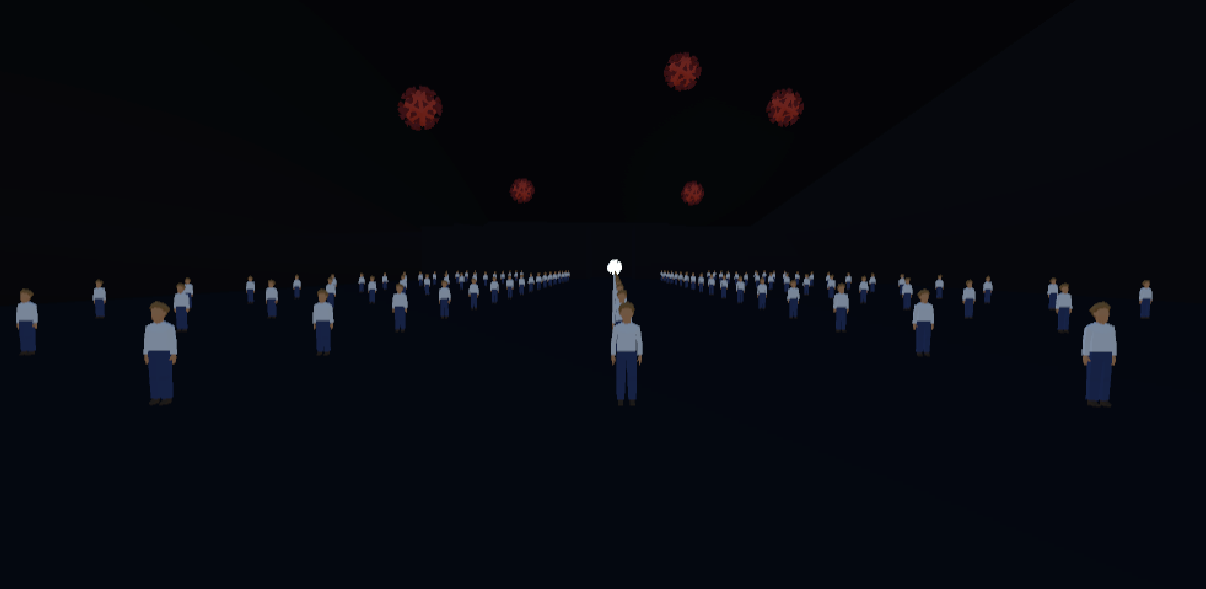La Pandemie is a narrative walking simulator about my student experience during the pandemic that was produced over the course of a month. The player plays through three levels centered around the experience of being a student as lockdown hit in 2020. My goal was to make a narrative game that could be played in 5 minutes or less.
This game was a solo project, with assistance for coding provided by Jason Corace. I designed and wrote scenarios for three singleplayer levels following a top-down approach.
La Pandemie is available for download here and is on Github here.
design choices
↓
↓
level one
The first level of La Pandemie involves the player, playing as a laboratory fish, making their way through a fish tank to obtain food at the end (which also acts as the trigger to send them to the next level). A recurrent design theme that I followed throughout La Pandemie is to have the fish act as a visual signal to the player for where they need to go to progress. Level one establishes this by having all of the fish act as a guiding line, pointing in the direction of the food (which also establishes the egg as an object of interest).
The player has the choice to interpret this and subsequently to navigate the level in two ways. The level can either be treated as an outright walking simulator, in which the player walks along the bottom of the tank and follows the fish to the end, or (as suggested by the only fish that is not pointing in the direction of the egg, who is present at the beginning of the level and speaks to the player) they can platform on top of the fish to make it to the egg. The fish are spaced so that it is possible to make it from the first fish to the egg without ever touching the floor of the tank.
level two
The second level of La Pandemie pivots to the perspective of the student as the pandemic begins. I kept the level design in the second level comparatively much more simple, as I felt the drastic change in atmosphere and much heavier focus on dialogue interactions provoked the desired emotional response as is. I wanted to create a space that felt simultaneously suffocating to the player and yet also did not provide a direct sense of space. In order to achieve this, I encased the player in a shell-like area and used the same black material for all of the floor, wall, and ceiling surfaces.
Following the theme of the fish as a guiding line, I displayed the fish tank that the first level takes place in as the first thing that the player sees when spawning into the level. The fish in the tank, as well as the linearity of the people placed throughout the scene and the comparative brightness of the virus object at the end of the level, create a distinct visual line that the player follows to reach the end of the level.
In order to capture the emotion of that initial pandemic overwhelmingness, I also spaced different interactable people throughout the level at a distance where it is near impossible to walk through without triggering any of the dialogue (all of the dialogue is the same and is triggered by entering colliders), which reads “you’re not social distancing”. This combined with the background audio of whispering creates an unsettling, horror theme that is reinforced by the visual appearance and atmosphere of the level.
level three
The third and final level of La Pandemie shifts back to the student perspective, though it takes place in a much more whimsical, mindspace-esque environment than the first two levels do. Visually, I wanted this level to feel more like the fish tank, but without the implied constraints of being in an enclosed space that both the first and second level suggest through their environments. I once again maintained the theme of the fish pointing the player in the direction that they need to go to, though slightly less literally at the beginning. As the player initially starts on the floor, the first group of fish point towards the stairs that the player mounts to access the rest of the level, and the rest of the fish subsequently act as platforms that the player can use to navigate towards the end of the level.
As this level is more whimsical, I likewise wanted the level design to be less linear and to allow the player to take multiple different paths. Reusing the visual motif of the people from the second level, I positioned several different people, each with different dialogue prompts (which each discuss different brief retrospective analyses on different moments from my experience in the pandemic), throughout the level at points where different paths intersect. The combination of the intersection of the different paths, but also the fish pointing towards the end of the level, allows the player to go through the level and explore it in any particular direction that they want without getting lost. Each of the people having different dialogue prompts also encourages the player to explore the entire level so that they can obtain as much narrative content as possible.









